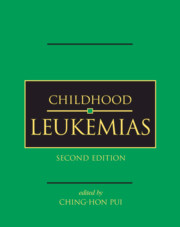Book contents
- Frontmatter
- Contents
- List of contributors
- Preface
- Part I History and general issues
- Part II Cell biology and pathobiology
- Part III Evaluation and treatment
- 14 Pharmacokinetic, pharmacodynamic, and pharmacogenetic considerations
- 15 Assays and molecular determinants of cellular drug resistance
- 16 Acute lymphoblastic leukemia
- 17 Relapsed acute lymphoblastic leukemia
- 18 B-cell acute lymphoblastic leukemia and Burkitt lymphoma
- 19 Acute myeloid leukemia
- 20 Relapsed acute myeloid leukemia
- 21 Myelodysplastic syndrome
- 22 Chronic myeloproliferative disorders
- 23 Hematopoietic stem cell transplantation
- 24 Acute leukemia in countries with limited resources
- 25 Antibody-targeted therapy
- 26 Adoptive cellular immunotherapy
- 27 Gene transfer: methods and applications
- 28 Minimal residual disease
- Part IV Complications and supportive care
- Index
- Plate Section between pages 400 and 401
- References
21 - Myelodysplastic syndrome
from Part III - Evaluation and treatment
Published online by Cambridge University Press: 01 July 2010
- Frontmatter
- Contents
- List of contributors
- Preface
- Part I History and general issues
- Part II Cell biology and pathobiology
- Part III Evaluation and treatment
- 14 Pharmacokinetic, pharmacodynamic, and pharmacogenetic considerations
- 15 Assays and molecular determinants of cellular drug resistance
- 16 Acute lymphoblastic leukemia
- 17 Relapsed acute lymphoblastic leukemia
- 18 B-cell acute lymphoblastic leukemia and Burkitt lymphoma
- 19 Acute myeloid leukemia
- 20 Relapsed acute myeloid leukemia
- 21 Myelodysplastic syndrome
- 22 Chronic myeloproliferative disorders
- 23 Hematopoietic stem cell transplantation
- 24 Acute leukemia in countries with limited resources
- 25 Antibody-targeted therapy
- 26 Adoptive cellular immunotherapy
- 27 Gene transfer: methods and applications
- 28 Minimal residual disease
- Part IV Complications and supportive care
- Index
- Plate Section between pages 400 and 401
- References
Summary
Introduction
Myelodysplastic syndrome (MDS) is a clonal myeloid malignancy characterized by the triad of growth advantage of clonal cells, disturbed differentiation and increased apoptosis. The malignant cells have retained some capacity for differentiation, and have the propensity to undergo apoptosis in the bone marrow; hence, in contrast to acute leukemia, there is a lack of blast cell domination of bone marrow. MDS is much rarer in children than in adults, and most of the literature on this disease is based upon studies in elderly patients; however, there are significant differences between MDS in children and adults (Table 21.1), including the morphologic features and cytogenetic findings at diagnosis. Many children have associated abnormalities (e.g. pre-existing bone marrow failure or congenital abnormalities). The therapeutic aim in children with MDS is primarily a cure, whereas this possibility is often not realistic in adults. The rarity of MDS in children and the lack of a widely accepted classification have contributed to the paucity of reports on this malignancy in the pediatric literature, although in recent years increasing attention has been paid to childhood MDS patients.
Classification of childhood MDS - historical background
The classification of childhood MDS has been inconsistent and confusing. MDS was not included in the official classification of childhood malignancies until the revised version published in 2005. The rarity and heterogeneous nature of the disease have further contributed to the difficulties in its classification.
A plethora of names have been used over the last decades to designate MDS, reflecting the conceptual and diagnostic ambiguity surrounding this disorder.
- Type
- Chapter
- Information
- Childhood Leukemias , pp. 548 - 570Publisher: Cambridge University PressPrint publication year: 2006
References
- 1
- Cited by



